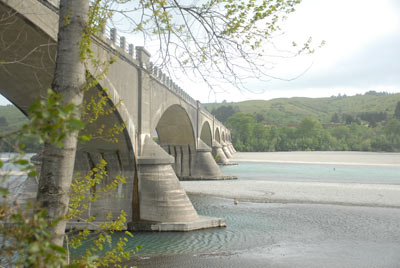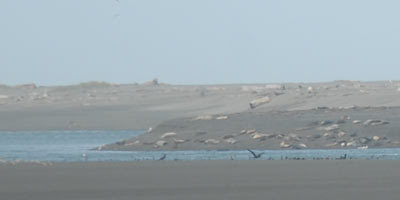Fiction: "The Potter Valley Project is solely responsible for decimating the salmon and steelhead populations in the entire Eel River watershed."
The Eel River watershed has had numerous natural and human caused destructive events in the past 160 years.
 Long before the Project was built in 1906, commercial fishing had nearly destroyed the Eel River fishery. Commercial fishing was historically allowed in the Eel River and millions of pounds of salmon and steelhead were caught with nets in the estuary and canned. By the late 1800's, there was a serious decline in the salmon population in the River. The following quote clearly describes how desperate the situation was for fish: "The gradual disappearance of the salmon is something that should concern this coast. The catch in the last year is only a fraction of that of years gone by and the salmon will soon be extinct in California waters unless some adequate measures are taken. There is no mystery in the cause of the decline of the salmon. The fish have been mercilessly hunted. There is no stream on the Pacific Coast that is fished as closely as the Eel River. Whether anything can be done for California streams or not is doubtful". This was an editorial that appeared in the Ferndale Enterprise in 1893, fifteen years before the diversion tunnel for the Potter Valley Project was completed and 29 years before Scott Dam was built. After much lobbying, the legislature began to restrict fishing in the Eel River until commercial fishing in the Eel River was completely banned in 1926. Off shore commercial fishing continued. The population of salmon up and down the west coast was severely impacted by commercial fishing and by the 1950s serious reductions in the population of salmonids had occurred in most west coast rivers. In 1986 A.F. McEvoy wrote a book titled "The Fisherman's Problem: Ecology and Law in the California Fisheries, 1850-1980" in which he attributed the post World War II dramatic declines in west coast fisheries directly to mechanization and poor fishery management policies. FERC reports (FERC 1978) the annual commercial take of salmon in Humboldt County (off shore), from 1960 to 1962, averaged 1,612,000 pounds. The reported annual commercial take of salmon in Humboldt County, from 1971-1973 was 1,817,000 pounds (ibid FERC 1978) Commercial fishing has now been strongly regulated for our American fishermen, but not the offshore interests of other countries that continue to catch and can, untold numbers of our west coast salmon in their factory ships.
Long before the Project was built in 1906, commercial fishing had nearly destroyed the Eel River fishery. Commercial fishing was historically allowed in the Eel River and millions of pounds of salmon and steelhead were caught with nets in the estuary and canned. By the late 1800's, there was a serious decline in the salmon population in the River. The following quote clearly describes how desperate the situation was for fish: "The gradual disappearance of the salmon is something that should concern this coast. The catch in the last year is only a fraction of that of years gone by and the salmon will soon be extinct in California waters unless some adequate measures are taken. There is no mystery in the cause of the decline of the salmon. The fish have been mercilessly hunted. There is no stream on the Pacific Coast that is fished as closely as the Eel River. Whether anything can be done for California streams or not is doubtful". This was an editorial that appeared in the Ferndale Enterprise in 1893, fifteen years before the diversion tunnel for the Potter Valley Project was completed and 29 years before Scott Dam was built. After much lobbying, the legislature began to restrict fishing in the Eel River until commercial fishing in the Eel River was completely banned in 1926. Off shore commercial fishing continued. The population of salmon up and down the west coast was severely impacted by commercial fishing and by the 1950s serious reductions in the population of salmonids had occurred in most west coast rivers. In 1986 A.F. McEvoy wrote a book titled "The Fisherman's Problem: Ecology and Law in the California Fisheries, 1850-1980" in which he attributed the post World War II dramatic declines in west coast fisheries directly to mechanization and poor fishery management policies. FERC reports (FERC 1978) the annual commercial take of salmon in Humboldt County (off shore), from 1960 to 1962, averaged 1,612,000 pounds. The reported annual commercial take of salmon in Humboldt County, from 1971-1973 was 1,817,000 pounds (ibid FERC 1978) Commercial fishing has now been strongly regulated for our American fishermen, but not the offshore interests of other countries that continue to catch and can, untold numbers of our west coast salmon in their factory ships.
The devastating floods of 1955, and particularly 1964, caused tremendous damage to the river. In many areas throughout the watershed the scars left by these floods are still evident as riparian vegetation was ripped away and torrents of water changed the spawning beds and tore out roads leaving culverts in the air where, even today, access to countless tributaries is still denied to migrating fish.
Road building, logging, agriculture and construction have also impacted the Eel River Watershed.
 Declining numbers of fish are not protected from seals and sea lions at the mouth of the Eel River, where they are easy prey, as they run a gauntlet of hungry predators.
Declining numbers of fish are not protected from seals and sea lions at the mouth of the Eel River, where they are easy prey, as they run a gauntlet of hungry predators.
Ocean currents are never static and the effects of natural fluctuations in these currents on the food source for salmon and steelhead (i.e. decadal oscillations) in these vast rivers in the sea are not completely understood.
We know that the introduced predatory Sacramento Pikeminnow (Ptychocheilus grandis) have had a profound impact on juvenile salmonids since the mid 1980's.
The effect of each of these impacts is amplified as the population of salmonids declines.
Clearly, the fact that salmon and steelhead populations have declined in rivers, with and without dams, all along the western coast of North America necessarily points to other causes than just the Potter Valley Project.
If the Friends of the Eel River really cared about the Eel River, they would direct more of their energy to helping understand these other impacts and not focus solely on the Potter Valley Project.
 Long before the Project was built in 1906, commercial fishing had nearly destroyed the Eel River fishery. Commercial fishing was historically allowed in the Eel River and millions of pounds of salmon and steelhead were caught with nets in the estuary and canned. By the late 1800's, there was a serious decline in the salmon population in the River. The following quote clearly describes how desperate the situation was for fish: "The gradual disappearance of the salmon is something that should concern this coast. The catch in the last year is only a fraction of that of years gone by and the salmon will soon be extinct in California waters unless some adequate measures are taken. There is no mystery in the cause of the decline of the salmon. The fish have been mercilessly hunted. There is no stream on the Pacific Coast that is fished as closely as the Eel River. Whether anything can be done for California streams or not is doubtful". This was an editorial that appeared in the Ferndale Enterprise in 1893, fifteen years before the diversion tunnel for the Potter Valley Project was completed and 29 years before Scott Dam was built. After much lobbying, the legislature began to restrict fishing in the Eel River until commercial fishing in the Eel River was completely banned in 1926. Off shore commercial fishing continued. The population of salmon up and down the west coast was severely impacted by commercial fishing and by the 1950s serious reductions in the population of salmonids had occurred in most west coast rivers. In 1986 A.F. McEvoy wrote a book titled "The Fisherman's Problem: Ecology and Law in the California Fisheries, 1850-1980" in which he attributed the post World War II dramatic declines in west coast fisheries directly to mechanization and poor fishery management policies. FERC reports (FERC 1978) the annual commercial take of salmon in Humboldt County (off shore), from 1960 to 1962, averaged 1,612,000 pounds. The reported annual commercial take of salmon in Humboldt County, from 1971-1973 was 1,817,000 pounds (ibid FERC 1978) Commercial fishing has now been strongly regulated for our American fishermen, but not the offshore interests of other countries that continue to catch and can, untold numbers of our west coast salmon in their factory ships.
Long before the Project was built in 1906, commercial fishing had nearly destroyed the Eel River fishery. Commercial fishing was historically allowed in the Eel River and millions of pounds of salmon and steelhead were caught with nets in the estuary and canned. By the late 1800's, there was a serious decline in the salmon population in the River. The following quote clearly describes how desperate the situation was for fish: "The gradual disappearance of the salmon is something that should concern this coast. The catch in the last year is only a fraction of that of years gone by and the salmon will soon be extinct in California waters unless some adequate measures are taken. There is no mystery in the cause of the decline of the salmon. The fish have been mercilessly hunted. There is no stream on the Pacific Coast that is fished as closely as the Eel River. Whether anything can be done for California streams or not is doubtful". This was an editorial that appeared in the Ferndale Enterprise in 1893, fifteen years before the diversion tunnel for the Potter Valley Project was completed and 29 years before Scott Dam was built. After much lobbying, the legislature began to restrict fishing in the Eel River until commercial fishing in the Eel River was completely banned in 1926. Off shore commercial fishing continued. The population of salmon up and down the west coast was severely impacted by commercial fishing and by the 1950s serious reductions in the population of salmonids had occurred in most west coast rivers. In 1986 A.F. McEvoy wrote a book titled "The Fisherman's Problem: Ecology and Law in the California Fisheries, 1850-1980" in which he attributed the post World War II dramatic declines in west coast fisheries directly to mechanization and poor fishery management policies. FERC reports (FERC 1978) the annual commercial take of salmon in Humboldt County (off shore), from 1960 to 1962, averaged 1,612,000 pounds. The reported annual commercial take of salmon in Humboldt County, from 1971-1973 was 1,817,000 pounds (ibid FERC 1978) Commercial fishing has now been strongly regulated for our American fishermen, but not the offshore interests of other countries that continue to catch and can, untold numbers of our west coast salmon in their factory ships.
 Declining numbers of fish are not protected from seals and sea lions at the mouth of the Eel River, where they are easy prey, as they run a gauntlet of hungry predators.
Declining numbers of fish are not protected from seals and sea lions at the mouth of the Eel River, where they are easy prey, as they run a gauntlet of hungry predators.